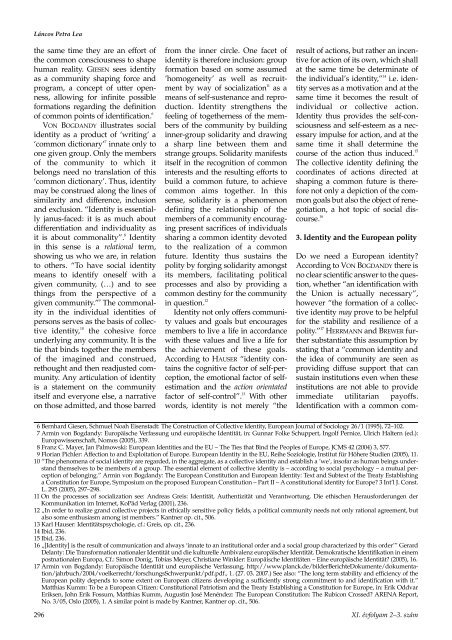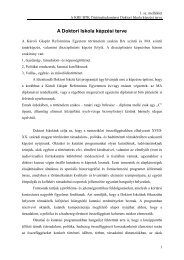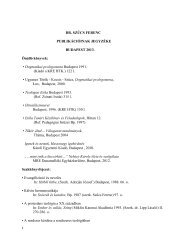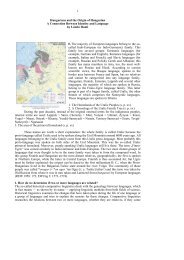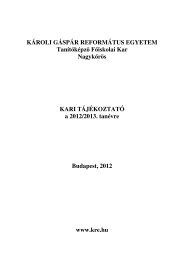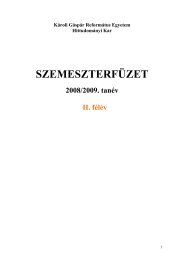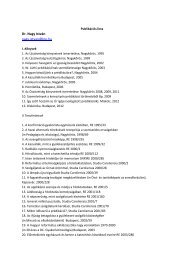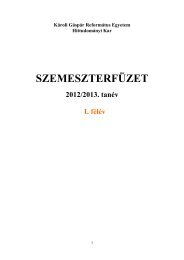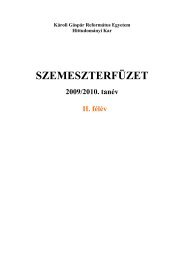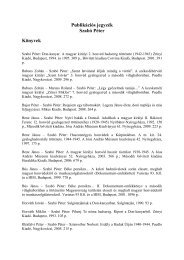collega - Károli Gáspár Református Egyetem
collega - Károli Gáspár Református Egyetem
collega - Károli Gáspár Református Egyetem
You also want an ePaper? Increase the reach of your titles
YUMPU automatically turns print PDFs into web optimized ePapers that Google loves.
Láncos Petra Lea<br />
the same time they are an effort of<br />
the common consciousness to shape<br />
human reality. GIESEN sees identity<br />
as a community shaping force and<br />
program, a concept of utter openness,<br />
allowing for infinite possible<br />
formations regarding the definition<br />
of common points of identification. 6<br />
VON BOGDANDY illustrates social<br />
identity as a product of ‘writing’ a<br />
‘common dictionary’ 7 innate only to<br />
one given group. Only the members<br />
of the community to which it<br />
belongs need no translation of this<br />
‘common dictionary’. Thus, identity<br />
may be construed along the lines of<br />
similarity and difference, inclusion<br />
and exclusion. “Identity is essentially<br />
janus-faced: it is as much about<br />
differentiation and individuality as<br />
it is about commonality”. 8<br />
Identity<br />
in this sense is a relational term,<br />
showing us who we are, in relation<br />
to others. “To have social identity<br />
means to identify oneself with a<br />
given community, (…) and to see<br />
things from the perspective of a<br />
given community.” 9 The commonality<br />
in the individual identities of<br />
persons serves as the basis of collective<br />
identity, 10<br />
the cohesive force<br />
underlying any community. It is the<br />
tie that binds together the members<br />
of the imagined and construed,<br />
rethought and then readjusted community.<br />
Any articulation of identity<br />
is a statement on the community<br />
itself and everyone else, a narrative<br />
on those admitted, and those barred<br />
from the inner circle. One facet of<br />
identity is therefore inclusion: group<br />
formation based on some assumed<br />
’homogeneity’ as well as recruitment<br />
by way of socialization 11<br />
as a<br />
means of self-sustenance and reproduction.<br />
Identity strengthens the<br />
feeling of togetherness of the members<br />
of the community by building<br />
inner-group solidarity and drawing<br />
a sharp line between them and<br />
strange groups. Solidarity manifests<br />
itself in the recognition of common<br />
interests and the resulting efforts to<br />
build a common future, to achieve<br />
common aims together. In this<br />
sense, solidarity is a phenomenon<br />
defining the relationship of the<br />
members of a community encouraging<br />
present sacrifices of individuals<br />
sharing a common identity devoted<br />
to the realization of a common<br />
future. Identity thus sustains the<br />
polity by forging solidarity amongst<br />
its members, facilitating political<br />
processes and also by providing a<br />
common destiny for the community<br />
in question. 12<br />
Identity not only offers community<br />
values and goals but encourages<br />
members to live a life in accordance<br />
with these values and live a life for<br />
the achievement of these goals.<br />
According to HAUSER “identity contains<br />
the cognitive factor of self-perception,<br />
the emotional factor of selfestimation<br />
and the action orientated<br />
factor of self-control”. 13<br />
With other<br />
words, identity is not merely “the<br />
result of actions, but rather an incentive<br />
for action of its own, which shall<br />
at the same time be determinate of<br />
the individual’s identity,” 14 i.e. identity<br />
serves as a motivation and at the<br />
same time it becomes the result of<br />
individual or collective action.<br />
Identity thus provides the self-consciousness<br />
and self-esteem as a necessary<br />
impulse for action, and at the<br />
same time it shall determine the<br />
course of the action thus induced. 15<br />
The collective identity defining the<br />
coordinates of actions directed at<br />
shaping a common future is therefore<br />
not only a depiction of the common<br />
goals but also the object of renegotiation,<br />
a hot topic of social discourse.<br />
16<br />
3. Identity and the European polity<br />
Do we need a European identity?<br />
According to VON BOGDANDY there is<br />
no clear scientific answer to the question,<br />
whether “an identification with<br />
the Union is actually necessary”,<br />
however “the formation of a collective<br />
identity may prove to be helpful<br />
for the stability and resilience of a<br />
polity.” 17 HERRMANN and BREWER further<br />
substantiate this assumption by<br />
stating that a “common identity and<br />
the idea of community are seen as<br />
providing diffuse support that can<br />
sustain institutions even when these<br />
institutions are not able to provide<br />
immediate utilitarian payoffs.<br />
Identification with a common com-<br />
6 Bernhard Giesen, Schmuel Noah Eisenstadt: The Construction of Collective Identity, European Journal of Sociology 26/1 (1995), 72–102.<br />
7 Armin von Bogdandy: Europäische Verfassung und europäische Identität, in: Gunnar Folke Schuppert, Ingolf Pernice, Ulrich Haltern (ed.):<br />
Europawissenschaft, Nomos (2005), 339.<br />
8 Franz C. Mayer, Jan Palmowski: European Identities and the EU – The Ties that Bind the Peoples of Europe, JCMS 42 (2004) 3, 577.<br />
9 Florian Pichler: Affection to and Exploitation of Europe. European Identity in the EU, Reihe Soziologie, Institut für Höhere Studien (2005), 11.<br />
10 “The phenomena of social identity are regarded, in the aggregate, as a collective identity and establish a ’we’, insofar as human beings understand<br />
themselves to be members of a group. The essential element of collective identity is – according to social psychology – a mutual perception<br />
of belonging.” Armin von Bogdandy: The European Constitution and European Identity: Text and Subtext of the Treaty Establishing<br />
a Constitution for Europe, Symposium on the proposed European Constitution – Part II – A constitutional identity for Europe? 3 Int’l J. Const.<br />
L. 295 (2005), 297–298.<br />
11 On the processes of socialization see: Andreas Greis: Identität, Authentizität und Verantwortung. Die ethischen Herausforderungen der<br />
Kommunikation im Internet, KoPäd Verlag (2001), 236.<br />
12 „In order to realize grand collective projects in ethically sensitive policy fields, a political community needs not only rational agreement, but<br />
also some enthusiasm among ist members.” Kantner op. cit., 506.<br />
13 Karl Hauser: Identitätspsychologie, cf.: Greis, op. cit., 236.<br />
14 Ibid, 236.<br />
15 Ibid, 236.<br />
16 „[Identity] is the result of communication and always ‘innate to an institutional order and a social group characterized by this order’” Gerard<br />
Delanty: Die Transformation nationaler Identität und die kulturelle Ambivalenz europäischer Identität. Demokratische Identifikation in einem<br />
postnationalen Europa, Cf.: Simon Donig, Tobias Meyer, Christiane Winkler: Europäische Identitäten – Eine europäische Identität? (2005), 16.<br />
17 Armin von Bogdandy: Europäische Identität und europäische Verfassung, http://www.planck.de/bilderBerichteDokumente/dokumentation/jahrbuch/2004/voelkerrecht/forschungsSchwerpunkt/pdf.pdf.,<br />
1. (27. 03. 2007.) See also: “The long term stability and efficiency of the<br />
European polity depends to some extent on European citizens developing a sufficiently strong commitment to and identification with it.”<br />
Matthias Kumm: To be a European Citizen: Constitutional Patriotism and the Treaty Establishing a Constitution for Europe, in: Erik Oddvar<br />
Eriksen, John Erik Fossum, Matthias Kumm, Augustin José Menéndez: The European Constitution: The Rubicon Crossed? ARENA Report,<br />
No. 3/05, Oslo (2005), 1. A similar point is made by Kantner, Kantner op. cit., 506.<br />
296 XI. évfolyam 2–3. szám


